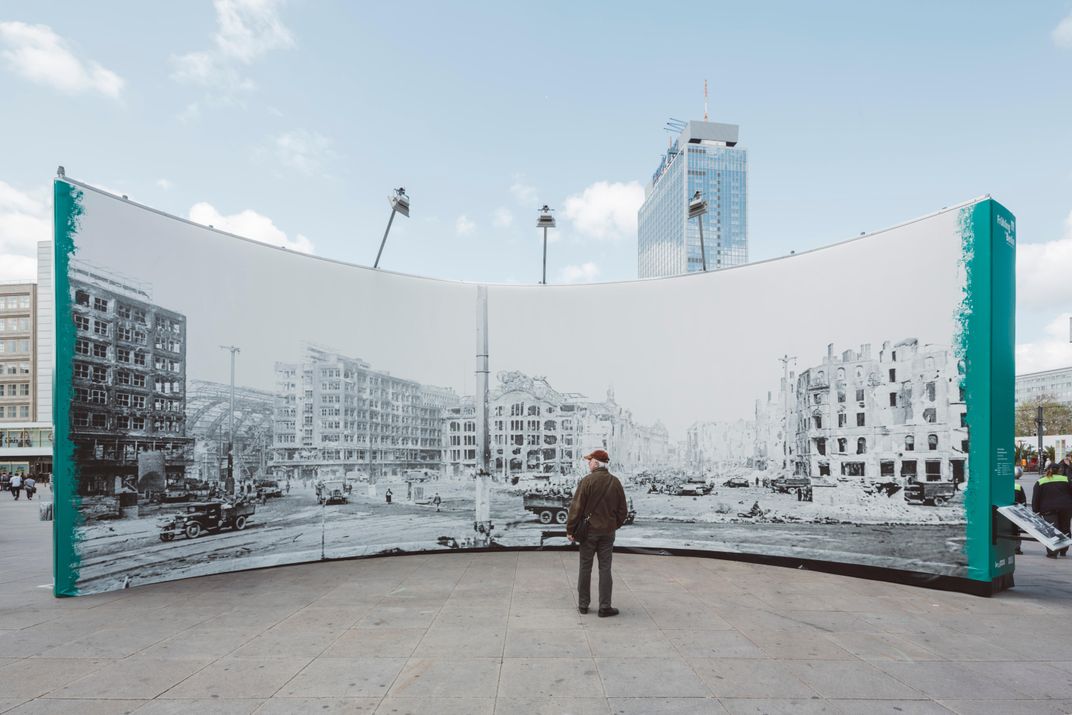Dramatic Images of Berlin in May 1945, Set Against the City’s Prosperous Present
“Spring in Berlin” compares Germany’s capital city at the end of World War II and today
Walking in Berlin today, it can be hard to envision a crumbling, war-torn city. Museums, art galleries, cafes and performance houses dot every corner. Citizens and tourists alike walk the streets, enjoying a city that's now one of Europe’s cultural capitals. So, it's understandable that passing a 60-foot-tall image of a destroyed Berlin in the heart of today’s Potsdamer Platz would be startling. “[People] are at first shocked, then for a few moments, they are quiet. Then, they usually turn to discuss with their neighbors,” says Moritz van Dülmen, project leader of "Spring in Berlin—May '45" and chief executive officer of KulturprojekteBerlin, a non-profit organization that promotes culture in the city.
For the citizens of Berlin, the spring of 1945 marked a time between war and peace, oppression and freedom. The Red Army crossed into Berlin on April 21, 1945, and the Battle of Berlin brought the surrender of Germany’s capital city. On May 8, the Nazis surrendered to the Allied Forces, bringing World War II in Europe to an end. The city was destroyed and lay in ruins. Basic necessities, such as food, water and medication, were scarce. For Berliners, hope for the future may have been the most scarce resource of all.
Seventy years later, Berlin is a modern, beautiful European city and hope for the future is bright, but memories of its difficult past remain. In commemoration of the anniversary of the war’s end and the tough times that followed, the city of Berlin, in conjunction with Kulturprojekte Berlin, has created “May ’45—Spring in Berlin,” an open-air exhibit meant to connect Berliners to the war that once engulfed their city. The project began on April 22, with an introduction by Berlin’s mayor Michael Müller, and runs through May 26. The city is hosting lectures, readings, film screenings and guided tours, but the real highlights are the 60-foot images placed in six iconic areas of the city, showing what Berlin looked like at those same spots during the spring of 1945.
These pictures are affecting, van Dülmen notes, because they allow immediate connection to the past. “It is pretty easy to imagine that exactly where I stand today in this place 70 years ago this was happening,” he says. He mentions having seen people gape, with their mouths open, at the image of the open-air hospital that once stood in front of the legendary Brandenburg Gate, looking as if they couldn't believe that their home was once a war zone.
The exhibit is also a chance for the city to experiment with a new approach for presenting history. Instead of attempting to get people to come to museums or indoor exhibits, the project brings the information to the people—Dülmen describes it as “history to-go.” He says, “We try to go to the people ... to provide context directly. It is history on the streets.”
As Berlin looks back at its war-torn past, it’s easy to draw comparisons to cities and countries that are ravaged by conflict today, such as Syria and South Sudan. “With these images, we tried to confront what was happening here 70 years ago and get people to imagine what a situation it was for the people of Berlin. Then, people think ... it is a similar situation to what is happening with the people of Syria,” says Dülmen. While one war ended in Berlin in May 1945, other conflicts persist across the globe—and these images serve as reminder of both war's destructive power as well as the human capacity to rebuild.
Planning Your Next Trip?
Explore great travel deals
Smithsonian magazine participates in affiliate link advertising programs. If you purchase an item through these links, we receive a commission.








